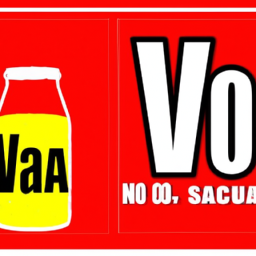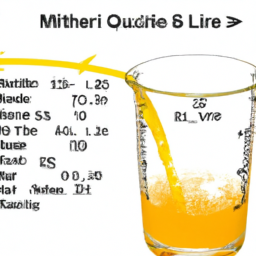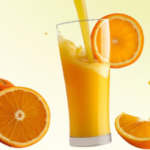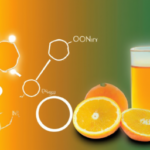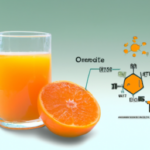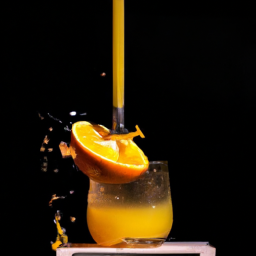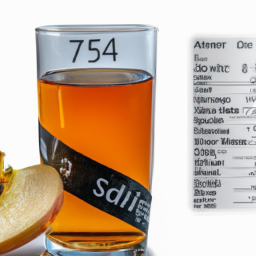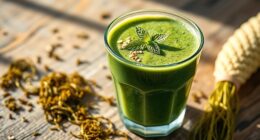As someone who cares about their health, you probably know the saying, “you are what you eat.” This simple yet powerful concept emphasizes the importance of being mindful about the food we eat.
One popular option for health-conscious individuals is V8 juice, a vegetable juice that boasts numerous health benefits. However, as with any food or drink, it’s important to know what you’re putting into your body, especially when it comes to sodium intake.
Sodium is an essential mineral that plays a crucial role in regulating our body’s fluid balance and nerve function. However, consuming too much sodium can lead to a host of health problems, including high blood pressure, heart disease, and stroke.
In this article, we’ll take a closer look at how much sodium is in V8 juice, as well as explore the health risks of consuming too much sodium and low-sodium alternatives to V8 juice. So, let’s dive in and learn more about the sodium content in V8 juice.
Key Takeaways
- V8 juice can be a convenient way to meet daily recommended intake of vitamins and minerals
- Original V8 juice contains a high amount of sodium, which can contribute to health problems with excessive intake
- Low-sodium versions of V8 juice are available as a healthier alternative
- It’s important to understand recommended serving sizes and moderation when consuming vegetable juice to avoid consuming too much sodium
The Importance of Sodium Intake
It’s crucial to consider one’s sodium intake when maintaining a healthy diet. Sodium is a mineral that our bodies need in small amounts to maintain fluid balance and nerve and muscle function. However, consuming too much sodium can lead to high blood pressure, increasing the risk of heart disease and stroke.
The recommended intake of sodium per day is no more than 2,300 milligrams for adults, and even less for those with certain health conditions such as high blood pressure. The main sources of sodium in our diets come from processed foods, such as fast food, canned soups, and packaged snacks.
By being mindful of these sources, we can make conscious choices to reduce our sodium intake and improve our overall health. With this in mind, let’s take a closer look at the sodium content in V8 juice as a popular beverage choice.
Overview of V8 Juice
V8 Juice contains a blend of vegetables that can help you meet your daily recommended intake of vitamins and minerals. This popular juice is made from a mixture of vegetables such as tomatoes, carrots, beets, celery, and spinach, among others.
It is available in various flavors, including original, spicy hot, low-sodium, and splash. Apart from its nutritional benefits, V8 Juice is also a tasty drink that comes in different flavors to suit your taste preferences.
The original flavor has a savory taste that is perfect for those who enjoy the pure taste of vegetables, while the spicy hot flavor adds a kick of spice to the mix. Additionally, the low-sodium and splash flavors offer alternatives for those watching their sodium intake or who prefer a fruitier taste.
Overall, V8 Juice is a convenient and delicious way to incorporate vegetables into your daily diet. With that said, it’s important to note the sodium content in V8 Juice, which will be discussed in the next section.
Sodium Content in V8 Juice
You may want to be mindful of the amount of salt present in this popular vegetable drink. While V8 juice is generally considered a healthy beverage, it’s important to remember that it contains a significant amount of sodium.
Benefits of sodium include regulating fluid balance, maintaining nerve and muscle function, and supporting heart health. However, the recommended intake levels for sodium are no more than 2,300 milligrams per day for most adults, with an ideal limit of 1,500 milligrams for those with high blood pressure, diabetes, or kidney disease.
The sodium content in V8 juice varies based on the specific variety. For example, the Original V8 juice contains 640 milligrams of sodium per 8-ounce serving, while the Low Sodium version contains only 140 milligrams. Other varieties, such as the V8 Spicy Hot and V8 Bloody Mary Mix, may contain even more sodium due to added spices and seasonings.
It’s important to check the nutrition label before consuming any variety of V8 juice to ensure it aligns with your recommended daily sodium intake. With this information in mind, let’s now delve into the potential health risks of consuming too much sodium.
Health Risks of Consuming Too Much Sodium
Consuming excessive amounts of sodium can lead to a range of health consequences. The recommended daily intake of sodium is 2,300 milligrams for healthy adults, and even lower for those with high blood pressure or other health conditions.
When we consume too much sodium, our body retains water to dilute the sodium concentration in our bloodstream. This extra fluid puts pressure on our blood vessels, leading to high blood pressure, which can increase our risk of heart disease and stroke.
In addition to these immediate health risks, a diet high in sodium can have long-term consequences. Over time, high blood pressure can damage our blood vessels, making it more difficult for blood to flow through our body. This can lead to a range of health problems, including kidney disease, vision loss, and cognitive decline.
For these reasons, it’s important to be mindful of our sodium intake and choose low-sodium alternatives whenever possible. One low-sodium alternative to consider is opting for fresh fruits and vegetables instead of processed foods. These whole foods are naturally low in sodium and provide a range of other nutrients that are important for our health.
Another option is to make your own vegetable juice at home using fresh ingredients and limited added salt. By making small changes to our diet, we can reduce our sodium intake and lower our risk of these serious health consequences.
Low-Sodium Alternatives to V8 Juice
I’ve been trying to cut down on my sodium intake lately, and one way I’ve been doing that is by exploring low-sodium alternatives to V8 juice.
I’ve found that making my own vegetable juice is a great option because I can control the ingredients and the amount of sodium.
I’ve also discovered some store-bought low-sodium vegetable juices that are tasty and convenient.
Homemade Vegetable Juice Recipes
Feeling adventurous in the kitchen? Try making your own vegetable juice at home! Juicing techniques have come a long way, and there are plenty of options available to create a delicious and healthy drink.
You can use a juicer or a blender to extract the juice from your favorite vegetables, such as carrots, beets, kale, spinach, and cucumbers. Experiment with different flavor combinations to find the perfect mix for your taste buds. Some popular options include adding ginger or lemon for a zesty kick, or using apples or berries to sweeten the juice.
Making your own vegetable juice at home is not only a fun and creative way to get your daily dose of vitamins and minerals, but it’s also a healthier alternative to store-bought options. Store-bought low-sodium vegetable juices often contain added sugars or preservatives, which can undermine the benefits of the juice.
By making your own juice, you can control the ingredients and ensure that you’re getting the most nutrient-dense drink possible. So why not give it a try and see how easy and delicious it can be?
Store-Bought Low-Sodium Vegetable Juices
Now that we’ve explored some homemade vegetable juice recipes, let’s take a look at store-bought low-sodium vegetable juices. While making your own juice at home can be a fun and cost-effective way to enjoy the benefits of juicing, store-bought options can be a convenient and time-saving alternative.
Many popular vegetable juice brands offer low-sodium options that are perfect for those who are watching their salt intake. One popular brand is V8, which offers a low-sodium version of their original vegetable juice. This juice contains only 140mg of sodium per serving, compared to the 640mg found in the regular version. Other brands, such as Naked Juice, also offer low-sodium vegetable juice options.
Incorporating store-bought low-sodium vegetable juices into your diet can be a great way to get the benefits of juicing without the hassle of making your own juice from scratch.
Speaking of nutrition, it’s important to know how to read nutrition labels to ensure you’re making healthy choices. Let’s take a closer look at how to do just that in the next section.
How to Read Nutrition Labels
You can easily understand the nutrition information on food labels by looking for key values like calories, serving size, and sodium content. Reading comprehension is important when it comes to interpreting label claims, which can sometimes be misleading. For example, a package may advertise ‘low sodium,’ but upon closer inspection, the sodium content per serving may still be relatively high.
This is why it’s important to pay attention to the serving size listed on the label, as well as the daily recommended intake of sodium. When checking the sodium content, keep in mind that the American Heart Association recommends consuming no more than 2,300 milligrams of sodium per day, and ideally, aiming for just 1,500 milligrams per day.
To put this into perspective, a single teaspoon of table salt contains about 2,300 milligrams of sodium. Tips for reducing sodium intake include opting for fresh or frozen fruits and vegetables, cooking with herbs and spices instead of salt, and selecting low-sodium or sodium-free options when grocery shopping.
Tips for Reducing Sodium Intake
Opt for fresh or frozen fruits and vegetables, use herbs and spices instead of salt, and choose low-sodium or sodium-free options while grocery shopping to reduce your daily intake of sodium and improve your overall health. Making healthy swaps is a great way to reduce your sodium intake. For example, instead of reaching for potato chips or crackers for a snack, choose fresh fruit or vegetables like carrots or cucumbers. Additionally, try swapping out salty condiments like ketchup or soy sauce for flavorful seasonings like lemon juice, garlic, or hot sauce.
Another way to reduce your sodium intake is to choose low-sodium or sodium-free options while grocery shopping. Look for foods labeled "low-sodium"or "sodium-free"and compare labels to find the option with the lowest amount of sodium. This can also be applied to canned or frozen fruits and vegetables – look for those labeled as "no salt added"or "unsalted."By making these simple changes, you can improve your overall health and reduce your risk of high blood pressure and other health conditions associated with high sodium intake.
Incorporating these healthy swaps and selecting low-sodium options while grocery shopping can have a significant impact on your sodium intake and overall health. By reducing your sodium intake, you can lower your risk of high blood pressure, stroke, and heart disease. In the next section, we will explore other health benefits of vegetable juices.
Other Health Benefits of Vegetable Juices
If you’re looking to add a healthy boost to your diet, vegetable juices can be a great option. The benefits of juicing go beyond just hydration, as vegetable juices are packed with nutrients to give you a kickstart and help you hit the ground running.
Whether you’re looking for a quick energy boost or trying to incorporate more vitamins and minerals into your diet, vegetable juices can be a convenient and nutritious option. Nutrients in vegetable juices can vary depending on the vegetables used, but some common nutrients include vitamin C, vitamin A, potassium, and iron.
These nutrients are essential for maintaining a healthy immune system, promoting healthy skin and hair, and supporting healthy heart function. Incorporating vegetable juices into your diet can help you meet your daily recommended intake of these important nutrients. So why not try adding a glass of vegetable juice to your breakfast routine or as a mid-afternoon pick-me-up? Your body will thank you for it.
When it comes to making informed choices about your diet, it’s important to consider not only the nutrients you’re consuming, but also the potential downsides such as added sugars and sodium. One common concern with vegetable juices is their sodium content. So, how much sodium in V8 juice? We’ll explore that in the next section.
Making Informed Choices About Your Diet
Now that we’ve discussed the various health benefits of vegetable juices, it’s important to consider how much sodium is in these drinks. While vegetable juices can be a great way to consume important nutrients and vitamins, they can also be high in sodium, which can lead to negative health outcomes like high blood pressure.
It’s important to make informed choices about your diet and to understand the nutritional benefits of the foods and drinks you consume. To make sure you’re getting the most out of your vegetable juice, it’s important to check the label and understand the recommended serving size.
While vegetable juices can be a great way to get important nutrients and vitamins in your diet, it’s important to consume them in moderation and to make sure you’re not consuming too much sodium. Here are some tips for making informed choices about your diet:
- Check the label for the sodium content of your vegetable juice
- Understand the recommended serving size for the juice
- Consider mixing your vegetable juice with water to reduce the sodium content
- Look for low-sodium vegetable juice options
- Consider making your own vegetable juice at home to have more control over the ingredients and sodium content.
By following these tips, you can ensure that you’re getting the most out of your vegetable juice and making informed choices about your diet. Remember to always check the label and understand the recommended serving size to avoid consuming too much sodium.
Frequently Asked Questions
What are the other ingredients in V8 juice besides sodium?
I find V8 juice’s nutritional value to be well-rounded, as it contains a blend of eight different vegetables. The taste profile is a balance of savory and slightly sweet. Other ingredients include tomato juice, carrot juice, and celery juice.
Can V8 juice be harmful for people with high blood pressure or heart disease?
For those with high blood pressure or heart disease, it’s important to balance sodium intake. V8 juice can be high in sodium, so alternatives may be better. Consult with a healthcare provider for personalized advice.
How does the sodium content in V8 juice compare to other vegetable juices?
When comparing sodium content in vegetable juices, V8 juice tends to be on the higher end. However, it still provides a range of nutritional values, such as vitamins A and C, and can be a healthy addition to a balanced diet.
Is it safe to consume V8 juice on a daily basis?
Coincidentally, I was just researching the benefits and risks of consuming V8 juice daily. While it is a good source of nutrients, the high sodium content may be concerning. Alternatives or substitutes with lower sodium options may be a better choice.
Are there any natural ways to enhance the flavor of low-sodium vegetable juices?
I’ve found that adding a squeeze of lemon or lime, a pinch of cayenne pepper, or a few sprigs of fresh herbs like basil or mint can be natural enhancers to achieve flavor balance in low-sodium vegetable juices.
Conclusion
So, how much sodium is in V8 juice? As someone who’s conscious about their sodium intake, I’m happy to report that V8 juice offers a low-sodium option for those looking to incorporate more vegetables into their diet.
With only 140mg of sodium per serving, V8 juice is a great alternative to other high-sodium beverages.
However, some may argue that the taste of low-sodium V8 juice is lacking compared to its regular counterpart. While it’s true that the reduced sodium content may affect the flavor slightly, it’s important to remember that our taste buds can adapt and adjust to changes in our diet over time.
Plus, the health benefits of consuming more vegetables through V8 juice far outweigh any perceived taste differences.
So, next time you’re at the grocery store, reach for a low-sodium V8 juice and enjoy the many health benefits it has to offer.
Ilana has been a vegan for over 10 years. She originally made the switch for health reasons, but soon found herself becoming more and more passionate about the ethical and environmental implications of a vegan lifestyle. Ilana is the author of The Graceful Kitchen, a blog all about veganism. She loves to cook up delicious and nutritious vegan meals, and share her recipes with others who are interested in leading a cruelty-free life. Ilana is also a strong advocate for using whole foods as the foundation of a healthy diet, and believes that going vegan is one of the best ways to achieve this.
